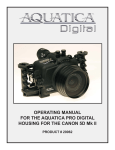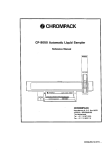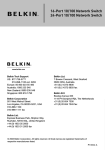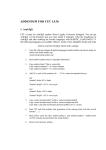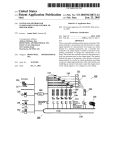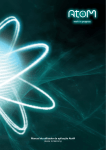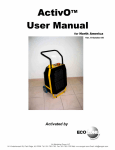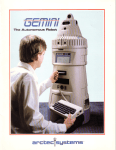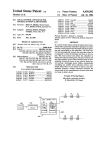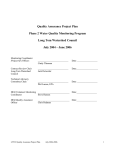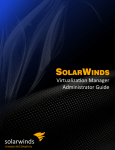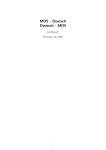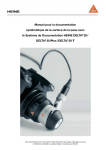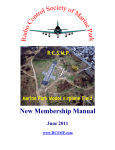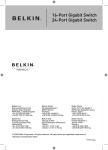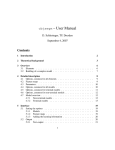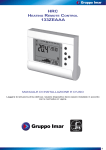Download Automatization in the design of image understanding systems
Transcript
Automatization in the Design of Image Understanding Systems Bernd R a d i g W. Eckstein 2, K. Klotz 2, T. M e s s e r 1, J. Pauli 2 1 Bayerisches Forschungszentrum fiir Wissensbasierte Systeme 2 Institut ftir Informatik IX, Teclmische Universit~it Miinchen Orleansstral~e 34, D-8000 Miinchen 80 Abstract. To understandthe meaningofan imageor imagesequence,to reducetheeffortin thedesignprocessand increasethereliabilityandthereusabilityofimageunderstandingsystems,a wide spectrum of AI techniquesis applied. Solvingan imageunderstandingproblem correspondsto specifyingan imageunderstandingsystem whichimplementsthe solutionto the givenproblem. Wedescribean imageunderstandingtoolboxwhichsupportsthe designof suchsystems.The toolbox includeshelpand tutormodules,an interactiveuserinterface,interfacesto commonprocedural and AI languages,and an automaticconfigurationmodule. 1 Introduction Machine Vision, and in general the interpretation of sensor signals, is an important field of Artificial Intelligence. A machine vision system coupled with a manipulator is able to act in our real world environment without the human being in the loop. Typical tasks of understanding the semantics of an image involve such applications as medical diagnosis of CT-images, traffic monitoring, visual inspection of surfaces etc. Given an image understanding problem to be solved for a specific application, usually a long process of incremental design begins. A huge space of parameters and decisions has to be mastered to achieve satisfying results. Illumination conditions, if they are under control, have to be experimentally set. Operators acting on input images and intermediate results have to be selected. The procedures implementing them are usually further specified by individual sets of parameters. Appropriate data structures have to be invented which somehow correspond to the image structures which have to be computed. The search space of interpretation hypotheses has to be managed and hypotheses have to be evaluated until a final result is obtained. No theory of Machine Vision exists to guide the design of an image understanding system and the methodological framework to support the design is not sufficiently developed. Therefore, to improve the efficiency of the design process and the quality of the result, tools have to be utilized which offer support for the different phases of the design process of an image understanding system. Most of those which are available now concentrate on fast prototyping of low-level image processing. Older tools merely consist of FORTRAN or C libraries (e.g. SPIDER [Tamura et al. 83]) of modules which implement typical signal and image processing operators, e.g. filters. Newer ones supply front ends which use some window-mouse based interaction, e.g. [Weymouth et al. 89]. A CASE-tool for constructing a knowledge based machine vision system will not be available in the near future. Nevertheless, some of the limitations of existing tools can be overcome by directing research into those phases of the design process in which parts can be operationalized and therefore incorporated into a next generation of those tools [Matsuyama 89], [Risk, B0mer 89], [Vernon, Sandini 88]. 36 2 Computer Aided Vision Engineering In solving a machine vision problem, an engineer follows more or less a general life-cycle model. He has to analyse the problem, collect a sample of typical images for testing, specify a coarse design on a conceptual level, match this design with available hardware and software modules, specify and implement some missing functionality, realize a prototype, perform tests using the collected set of images, improve the prototype, observe more and more constraints which accompany the transfer into real use, specify and implement the final system, validate the system using a different sample of images, monitor the system during operation, and do final modifications. In the first part of the life-cycle, to perform a feasibility study, fast prototyping is the usual strategy. Experience tells that in reality even for not to complex problems prototyping is slow. This was our motivation to start building a toolbox which supports machine vision engineering, especially suited for feasibility studieS. As a consequence of this focus, we omitted those parts which could handle real-time and process control requirements but concentrated on solving the image understanding problem. 2.1 Toolbox Properties A toolbox supporting fast prototyping should have some of the following properties: Sensor Input and Documentation Output Control. A wide variety of sensors may be utilized to take images and image sequences, e.g. CCD-camera, satellite, scanner etc., which deliver various image formats. Also a variety of display and hardcopy devices is in use, e.g. film recorder, colour-displays, black-and-white laser printers and the like. The toolbox should accept input from usual sources and produce output for usual display and hardcopy devices as well as for desktop publishing systems. Repertoire of Operators. The core of a toolbox are efficient operators which manipulate and analyse images and structural descriptions of images, e.g. affine transformations, linear filters, classifiers, neuronal networks, morphological operators, symbolic matching methods etc. If the toolbox provides uniform data structures and their management together with preformed interfaces, new operators can be easily incorporated. They should be written with portability in mind so that they can be transferred later into the target system and are reusable in other toolbox versions. Data Structures. The concept of abstract data structures has to be implemented to hide implementation details and to allow programming in different languages, e.g. C, C++, Pascal, PROLOG, LISP, and even AI shells to access these structures. System Architecture. Typical modules in a toolbox should be the internal data management system, an external image database management system, device drivers, operator base, network communication subsystem to allow for remote access and load sharing within a distributed environment, procedural interface with extensions specialized for each host language, graphical user interface, command history with undo, redo, replay facilities, online help, advice and guidance module, automatic operator configuration module, knowledge acquisition tool including editors for different forms of knowledge description and a consistency checker, and a code export manager which generates source or binary code for the operators and data structures, used in the prototype for compilation and linking in the target environment. 2.2 Goals Portability. To save investments into software, as well into the target systems as into the toolbox itself, such a system must be highly portable and has to generate reusable code for the target system. A UNIX environment for the toolbox and eventually for the runtime system, too, is the current choice. The user should not been forced - as far as possible - to invest time in integrating different hardware and software concepts and products before being sure that his idea 37 of a problem solution will work. Uniform Structures. If on all levels of an image understanding development system- signal processing through symbolic description - functions and data structure are presented in an uniform way which hides most implementation details, the user is motivated to explore even apparently complex constructs of operator sequences. He can easily combine and switch between different levels of abstraction in his program, focussed on functionality, on what-todo and not on how-to-do it. Interaction. This motivation has then to be supported by an highly interactive, "user friendly" toolbox interface which stimulates the engineer to test alternatives and not to think from the very beginning in terms of technical details and implementation effort. Tutorial, Tactical and Strategical Support. Of the user, especially anovice one, it cannot be expected that he is able to keep the functionality, applicability, and parameters of all image analysis methods, cast into operators and sequences of them, which the toolbox can offer in his mind. Therefore a tutorial, tactical and strategical support is a must. He needs advice what operators to select, what alternatives exists, how to determine parameter values for their arguments, time and space complexity to be expected, and how to optimize if the prototype does not produce acceptable results. Automatic Configuration. If the toolbox has some knowledge about the methods included in its operator base, automatic configuration becomes available. If at least a partial image understanding problem can be described in a formal way or even better by demonstrating examples and eventually counterexamples of what kind of image feature has to be detected, a configuration module could be able to choose an optimal sequence of optimal parameterized operators automatically from the operator base. First results in this direction are reported by [Ender 85], [Haas 87], [Hasegawa et al. 86], [Hesse, Klette 88], [Ikeuchi, Kanade 88], [Messer, Schubert 91], [Liedtke, Ender 89]. Automatic Adaption. If (a part of) an image understanding problem is given by supplying a generic model e.g. of the real world object to be detected or by showing representative exampies it becomes essential to guarantee the transfer the problem solution based on this description to the real operation of the final system. To do this with a minimum of the engineer's intervention, an automatic adaption or specialization of the generic description to the varying situations during operation has to be included into the design of the toolbox which in tum has to include this capability into the runtime system [Ender, Liedtke 86], [Pauli et al. 92]. Competence Awareness. If a machine vision system is able to adapt itself to (slightly) varying conditions it should be able to detect when its limited capabilities to follow changing situations is exceeded. To be able to report this is a prerequisite for controllable reliability. Then it can ask for human intervention, from manual parameter tuning through a complete redesign, to analyse and handle such situations. We do not believe that it is an easy task realizing a machine vision toolbox those properties striving at these goals. Automatic design and programming of problem solutions is a dream. Nevertheless, in such a special environment as image understanding is, methods of knowledge engineering, software engineering, and life-cycle support may b e - with greater success than in general data processing - combined into a form of computer aided vision engineering, CAVE. 3 The HORUS Project About five years ago, we started building two alternatives of tools intended to support research and education in image processing and understanding. One based on special hardware (digitizer, display system, Transputer board .... ) and special software (OCCAM) which required high competence in hardware and software engineering to become operational and to be main- 38 tained. This concept survived in a spin-off company of the author. The weak point with this approach is the intensive use of hardware dependant implementation and therefore the costly adaptation to technical innovations. The other alternative aimed at realizing some of the properties and goals as described in Chapter 2. Portability: As hardware platform for the HORUS toolbox a genetic UNIX workstation environment was chosen, using standard C as implementation language, TCP/IP protocols for communication, and XWindows and OSF/Motif to interact with the user [Eckstein 88a], [Eckstein 90]. The interfaces to the operating system are so well defined and localized that it has been transferred- with an effort of two hours through one d a y to different platforms such as DECStation Ultrix, even DECVAX VMS, HP9000 family, SUN Spare, Silicon Graphics family, and even multiprocessor machines such as Convex and Alliant. Load Sharing. If more than one processor is available in a workstation network or a multiprocessor machine, execution of operators can automatically be directed to aprocessor which has capacity left or which is especially suited, e.g. a signal or vector processor. The interprocess communication uses standard socket mechanisms, the load situation is monitored using Unix system commands [Langer, Eckstein 90]. Fig. 2. Sub windows class_2dlm [ class_ndi.1 [ class_ndi~2 [ dgn_ttmeshold ] ] ] ] [ ] ~t~r-~l~_t~os~ld] Interaction. A typical screen using the interactive version of HORUS looks as in Fig. 1. The user starts with the main menu (sub window 2 in Fig. 2) where he may open sub [ l~,_to_obJ ] window 8 to create or modify windows to display pictures or text, sub window 4 (see Fig. 3) to see a list of operators [ le.~Y'n_ndlml (organized in chapters) which are contained in HORUS, sub window 7 (see Fig. 4) to set parameters, sub window 1 to see a directory of images or image objects he hasused and produces in his session, or other windows to call the online help and manual, !'~'1 Im ~tto II ,,,-,gi,~l select input and output devices etc. Fig. 4 shows an example of the variety of parameters which control the display of Fig. 4. Default window parameters for image display ] 39 an image, in this example 3 colours, raster image, line width 1 pixel in white colour, default lookup table, default presentation (optimized for the screen), original shape, and display of the whole picture without zooming etc. Since HORUS knows which screen is in use, this menu automatically offers only such parameter values which are needed and applicable. High Level Programming. The engineer may choose the interactive exploration to get some feeling about which operators to apply in which sequence. A history of commands is logged which can be modified and executed again. Furthermore, HORUS offers a comfortable host language interface which allows the engineer to program his solution in a procedural (using C or Pascal as language), functional (LISP), object oriented (C++) or declarative (PROLOG) style [Eckstein 88b]. As an example a PROLOG (see Fig. 7) and an equivalent LISP program (Fig. 8) are given which solve the task of finding on a thick film ceramic board areas which are not covered correctly by solder (Fig. 5, 6). The basic idea is to illuminate the board from four sides in such a way, that the highlights form the contours of the lines where these are 40 covered by solder. The solution is then straightforward. -11~ By thresholding all pixels with an intensity value lower than 70 (this can be determined interactively) in each image L, R, O, U, an object Dark is obtained which contains r/~"a I I 11 four components of dark areas. A I I1~,................~/ union of these four pixel sets representing the lines is formed. Low Fig. 10. Missing solder on pass filtering, dynamic thresholdFig. 9. Highlights from four black regions ing, and set union produces the images contour image of Fig. 9. The threshold parameter is also selected by an interactively controlled test. The regions which are enclosed by contours are filled, forming a cover of all lines except where solder is missing. Subtracting this result from the object Line uncovers those areas. The remaining pixels are collected and connected regions are formed. Regions with an area of less than 20 pixels are excluded and the result is stored in the object Fault which is displayed in Fig.10. m m The LISP program is a transcription of the PROLOG program. The data structures are objects which have hidden components created and selected automatically by operators. This kind of abstraction allows the engineer to write compact programs without being involved in implementation details. m m ml~,.m m.ll~ HIll% kor.r-,~eI t ~ . ~o~rl~xltv: [ ............................ --.I Fig. 11. Error related window: information about operator EK3 ,dll.dI . t , t 1 , ~ di,,I D,l,,t,~,l 4~" E , , ~ , , , l ~ ll.l;~ l..,tAr ll~(,..~.,(Li..kin la.lp..lt ~ open access to related topics, e.g. description of operators with similar functionality or explanation of the meaning of the word threshold. The button parameter tells how to choose parameter values for this operator, the button abstract delivers a short description and the button manual gives a long description of the operator (Fig. 12). The manual is written in LATEX, therefore a standard UNIX tool has been used to provide the functionality of the manual management and a LATEX preview program generates the window. A new version will use a Postscript previewer which allows the inclusion of pictorial examples and Ifl,x~| dllitlonl llqfflrt ~ n ~ltt T~II[, /+111 dto rrM~t~' Help Modes. Operators perform exception handling to inform the user. A window is opened which displays related information (Fig. 11). Here the name of the operator where the error occurred is displayed. The bottom part of the window explains which result is generated and which errors arise in what situation, in this case dilation on an empty image. In the upper part of the window, a menu offers related information. Pressing the help button gives an explanation how to use these menus. The buttons keywords, see_also, and alternatives Inlll+l*l~ m ~ , 9 ..~ V.,,'~'t"k"l~ t ~ ' D i',t"l~'~ ~ ~, 4t....~k.l ~k.,~.~,~.i.k~m.--Wk'.r .. = 14,.~1 , ,dl~&*4k~14R,M } ~ ~ r~lR ! ' - m . w r-~ r-~ r-~ ~n,~k..,,1 sJR.z Au ~.: [-~ ~.ulu.l,tJu~ - ~ 9 ;, t , 9 ." ;< , ",.' : "" ~at~alxt~ Fig. 12. Section of the online user manual 41 explanations into the manual. In combination with PROLOG as the host language, the help module is currently enhanced by more functionality. One direction is to help the user to understand why an error occurred. It traces back the chain of PROLOG clauses to identify the place where a chain of computations and operator applications caused the generation of an invalid situation. Here debugging can be done on the same abstract level as programming. Iflul Tt~lll HRRUS-KapItnI: ~v,te! Flits" G'q'3hik Klal~lFtluJl;lorl ~tze 0b.ilkt Ses,~mt4ti~ Info C.tr teace IllRIJ~-.Praedlkete: crlultmJ~pfleld create.kt~t~n d~r do~l~rlpt.e]lllll r2 dwlgllm dtff_or diletl(~2 dl lit tl:,.Ltmlail d[ Ill;ll~.wq dlr~tlaqt __ II ~Jt,,~f-Preed I kat,e: l'~lt In|i; I lo (lx) Init, I 2, (11) The other direction is to analyse the actions which kleirmda~rtlkeI / 2. (1 .erke / 1o (2x) the user has performed during a session in the L I!1 PROLOG and in the HORUS system [Klotz 89]. Here the help systems monitors the user input and is therefore able to give more precise advice in : a i ~ i t (exliple ~ I 3 case the user needs help or an error message comes up. A first step in the realisation of this concept is the module operated by the window of Fig. 13. It Hler It0R~-lF/Prolol~omardos elr~enl provides the user with a complete list of predicates P 14 he has defined in field 2 and HORUS operators in field 1 which are from the point of view of PROFig. 13. HORUS! PROLOGdebuging LOG built-in predicates. Field 3 displays the history of actions which are available for inspection, modification and redo application. Field 4 accepts as input PROLOG and HORUS commands which are performed in the current context of execution. Similar concepts of debugging are well known from several LISP systems and applications. The innovation here is the uniform handling of actions in PROLOG as well as in HORUS. Further development will include the automatic analysis of interaction protocols to guide the user in understanding why an error occurred. Traces of rule activations and procedure calls as well as the assignment of variables at the moment when the error occurred will be available. The idea is to give the user a meaningful access to all those objects which might be associated with an exception, and to suggest alternatives for control structure and parameter values. Automatic Configuration. The online manual contains all information about HORUS operators which are needed for advice and guidance. Using this information, represented in a frame-based knowledge base [Polensky, Messer 89] together with basic knowledge of image processing, the module FIGURE [Messer 92a,b] is able to automatically generate image interpretation algorithms which are composed of operators from the HORUS operator base. In the current version, the configuration module is given an example of that kind of objects it should detect in an image or a sequence. This can be done interactively, e.g. using the mouse to indicate the region where the object is, or by some simple segmentation method. In the application illustrated in Fig. 14 the pins of the 42 Ja - ~. :,~, ~-:..z,a.r --zaa ..... integrated circuits have to be detected. FIGURE analyses the boundary, the background surrounding the object, and its interior. It then constructs a search space of all reasonable operators which might be applied. Various rules and constraints restrict the search space to a manageable size. Static restrictions help to determine the order of operators within the algorithm to be constructed. An example of such arule is:If dynamic thresholding is J~ '~"~ selected then it should be preceded by smoothing. The even ~~./~k ~-t~" !'~ : more difficult task is to supply the modules with values for their ~, l~.il~ ;'1;.'..|I llill,;~i! I I,YJII i:"~ parameters. Elementary knowledge about computer vision is included in the rule base as well as operator specific knowledge. Fig. 15. Small bright spots No domain specific knowledge is incorporated in the rule base. detected by operator These rules are rather simple, telling the system such elementary sequence first configured statements as for edge preserving smoothing a median filter is better than a low pass filter. Constraints between operators forbid e.g. applying a threshold operator on a binary image. But from the operator specific knowledge the system knows that a threshold operator needs a threshold value between I and 255. The quality of the generated proposals of operator sequences depends not only on the knowledge base but even more on the precision with which a vision problem can be described and the sequences can be evaluated. Of course, there is a correlation between both. Since at the moment a problem is described by indicating the boundary of a region which has to be extracted, two aspects are used for evaluation. The evaluation function takes into account how good the area of the found object matches the area of the given object and the distance between the boundaries of both objects. To force the configuration system to generate altemative sequences which include different operators in their sequences and not only different parameter values for essentially the same sequence, two templates are generated from the indicated boundary, namely a boundary oriented and aregion oriented one. The best of both altematives generated for these two classes survives. As an example consider the problem of detecting the pins of integrated circuits on a printed board as in Fig. 14. One pin's boundary is drawn, e.g. the one indicated by an arrow in Fig. 14. The configuration system generates an operator sequence which detects correctly most of the pins but also a lot of other small regions. The simple remedy is to filter out all regions which are not close to the body of the IC. Therefore, the detection oflC bodies is given as a second task to the configuration system. Fig. 16 shows the result. The closeness constraint cannot be implemented in the current version. The vision engineer has to do some programming, formulating such code as in Fig. 17. The arguments to the simple PROLOG rule are both images as inputs and the resulting image as output. For the IC bodies the contours of their convex hulls are computed. A circle of radius 5 pixels is defined and used to widen the contour, implementing the predicate close. A simple intersection of this image with that of the small regions eliminates most of the unwanted spots. It is obvious from Fig. 18 that the result is not completely correct. |il . I Figd~Cg~~ i '"" i'"* I ._l ~ nd I . . . . . . 1'i -. ~ ; - . . , .-. -i ~ , Fig. 18. Spots close to IC boundary, combined from both results, mostly pins ! 43 Anyhow, the automatic configuration is utilized here in the context of rapid prototyping. The result gives a good starting point to improve on. To prepare this example for this paper took less than one hour. It could be done on a very abstract but natural level in terms of design decisions such asfind small bright regions close to IC bodies. Two mouse interactions and one PROLOG rule implemented it. Model Adaptation. The models for describing objects, used so far, are simple closed contours. This is, of course, not sufficient for the analysis of more complex situations [Liedtke, Ender 86] where scenes are to be composed of objects constructed as a part-of hierarchy and related by constraints [Fickenscher 91 ]. The more complex such models are the more difficult it will be to attempt a generalizable description. A typical situation exists in an image sequence with moving objects [Nitzl, Pauli 91 ]. Here the model of an region in each image has to follow the expected or predicted changes. Varying attributes are area, boundary, shape, greyvalue, position, contrast to background etc. as well as relations such as below, darker, between, inside etc. In the example of Fig. 19 which shows the first frame of a sequence, a man is moving his right leg. A part-of hierarchy can easily be constructed, guided by the segmentation result of Fig. 20. A model of the right leg is obtained by specifying an elongated nearly vertical region whose centre of gravity is left of a similar region, both connected to a more compact region which is above. Fig. 22 consists of an overlay of Fig. 20 and the isolated right leg in different positions. For matching the model with the image structure, maximal cliques (totally connected subgraphs) in an assignment graph are computed [Radig 84]. The nodes of the assignment graph are formed from potentially corresponding pairs of image and model elements. Edges in this graph link relational consistent assignments. This approach is able to establish correspondence even in the case of deviations of relation and attribute values. To match image and model structure is a NP-hard problem. Application of heuristics using some kind of A*-search techtuque reduces complexity [Pauli 90]. Other techniques of matching structures are presented in [Pfleger, Radig 90]. The problem of how to evaluate the quality of the match has received much attention in the last decade. A recent workshop on Robust Computer Vision [Ftirstner, Ruwiede192] discussed different approaches. 0 Fig. 20. Initial segmentation Fig. 21. Right leg 0 A major problem, solved only for simple situations, is the specification of tolerance parameters to attribute values given their interdependence by the relations which exists between different elements. It is impossible to describe analytically e.g. how the height and width of the rectangle circumscribing the leg in Fig. 22 varies with the motion. The length Fig. 22. Leg in of the boundary of the right leg is somehow related to the area of the motion enclosed region but impossible to state exactly. Even if for some relationships an exact dependency might be found, it usually becomes corrupted by the unreliability of the image processing methods, by noise, or by the effects of digital geometry on the rastered image. Therefore, variations of attribute values which should be tolerated by the matching process are not easily determined and need time consuming experimentation. The model adaptation module, to be enclosed in the HORUS toolbox, contains methods of qualitative reasoning to help the engineer determining trends of parameter values and to follow difficult interrelationships without violating consistency between those parameter tolerances. 44 4. Conclusion After more than twenty years of image understanding research the situation with respect to the methodology of designing image understanding systems is disappointing. A theory of computational vision still does not exists which guides the implementation of computer vision algorithms. Our approach originated from an engineering point of view. We identified some of the problems which decrease quality of the results and productivity of the design process in the area of image understanding. Obviously, we could not address all aspects and could not offer solutions to all the problems we are faced with. Our advantages in the problem areas of portability, user interfacing, paraUelisation, multi host language interfacing, tutorial support, high level debugging, model adaptation, reusability, and automatic configuration are sufficient to start integrating all related software modules in a toolbox for Computer Aided Vision Engineering. In the HORUS system the availability of an interactive and a high level programming interface, the online help and debugging system, and the automatic configuration module have been in use for some period of time. We use it extensively in a practical course on Computer Vision as part of our Computer Science curriculum. We observed a drastic increase of creative productivity of our students working on their exercises. Other Computer Vision Labs testing our system reported a similar experience. In the near future the model adaptation will be more closely integrated into HORUS. The tutorial module will be able to give recommendations to the designer which module and parameter values to c h o o s e - an interactive complement of the automatic configuration module. During the process of integration some new challenges will appear. One is the extension of the internal object data structure - which is effective and efficient for low- and medium-level processingto structures needed by high-level image understanding. A second problem is the description of operators in such the way that all modules are able to extract automatically that part of the information which it needs. To describe more than 400 operators ranging from a simple linear filter up to a complete Neural Network simulator is a time consuming task. To specify formally for an author of a new module how he has to encode for HORUS the knowledge about his operator is not solved in general. Nevertheless, we could demonstrate that some parts in the design process of image understanding systems can be automatized successfully. References [Eckstein 88a]: W. Eckstein: Das ganzheitlicheBildverarbeitungssystemHORUS, Proceedings 10thDAGM Symposium 1988, H. Bunke, O. Kiibler,P. Stucki (Eds.), Springer-Verlag,Berlin 1988 [Eckstein 88b]: W. Eckstein: Prologschnittstellezur Bildverarbeitung.Proceedings 1st IF/PrologUser Day, Chapter 5, Miinchen,June 10, 1988 [Eckstein90]: W. Eckstein: Reporton the HORUS-System. INTER,RevueInternationalde L'Industrie et du Commerce, No 634, Oct. 1990,pp. 22 lender 85] M. Ender:Designand Implementationof an Auto-ConfiguringKnowledgeBased VisionSystem,in: 2nd International Technical Symposium on Optical and Electro-Optical Applied Sciences and Engineering, ConferenceComputerVision for Robots, Dec. 1985, Cannes [Ender, Liedtke 86] M. Ender, C.-E. Liedtke: Repr'~entationder relevantenWissensinhalte in einem selbstadaptierenden regelbasierten Bilddeutungssystem,Proceedings 8th DAGM-Symposium 1986, G. Hartmann (Ed.), Springer-Verlag, Berlin 1986 [Fickenscher91] H. Fickenscher:Konstruktion von 2D-Modellsequenzenund -episodenaus 3D-ModeUenzur Analyseyon Bildfolgen,TeclmischeUniversit~tMiinchen,InstitutfiirInformatikIX, Diplomarbeit,1991 lF~Srstner,Ruwiedel 92] W. F6rsmer, R. Ruwiedel (Eds.): Robust Computer Vision, Proceedingsof the 2nd 45 International Workshop, March 1992 in Bonn, Herbert Wichmann Verlag, Karlsruhe 1992 [Haas 87] L_I. de Haas: Automatic Programmingof Machine Vision Systems, Proceedings 13th Intemationai Joint Conference on Artificial Intelligence 1987, Milano, 790 - 792 [Hasegawa et al. 86] J. Hasegawa, H. Kubota, J. Toriwaki: Automated Construction of Image Processing Procedures by Sample-Figure Presentation, Proceedings 8th International Conference on Pattern Recognition 1986, Paris, 586 - 588 [Hesse, Klette 88] R. Hesse, R. Klette: Knowledge-BasedProgram Synthesis for Computer Vision, Journal of New Generation Computer Systems 1 (1), 1988, 63 - 85 [Ikeuchi,Kanade 88] Katsushi Ikeuchi,TakeoKanade: AutomaticGenerationof Object RecognitionPrograms, Proceedings of the IEEE, Vol. 76, No. 8, August 1988, 1016 - 1035 [Klotz 89] K. Klotz: Uberwachte Ausfiihrungvon Prolog-Programmen.Proceedings 2nd IF/Prolog User Day, Chapter 9, Miinchen,June 16, 1989 [Langer, Eckstein 90]: W. Langer, W. Eckstein: Konzept und Realisierungdes netzwerkf'~h~igenBildverarbeitungssystemsHORUS, Proceedings 12thDAGM-Symposium,R. E.. Grol]kopf(Ed.), Springer-Verlag, Berlin 1990 [Liedtke, Ender 86] C.-E. Liedtke, M. Ender:A KnowledgeBased VisionSystemfor the AutomatedAdaptionto New Scene Contents, Proceedings8th InternationalConferenceon Pattern Recognition 1986,Paris, 795 797 [Liedtke, Ender 89] C.-E, Liedtke, M. Ender: WissensbasierteBildverarbeitung,Springer-Verlag,Berlin, 1989 [Matsuyama 89] T, Matsuyama: Expert Systems for Image Processing: Composition of Image Analysis Processes, in: Computer Vision, Graphics, and Image Processing 48, 1989, 22 - 49 [Messer 92a] T. Messer: Model-Based Synthesis of Vision Routines, in: Advances in Vision - Strategies and Applications, C. Archibald (ed.), Singapore, World Scientific Press, 1992, to appear [Messer 92b] Tilo Messer: AcquiringObject ModelsUsing VisionOperations,ProceedingsVision Interface'92, Vancouver, to appear [Messer, Schubert 91 ] T. Messer, M. Schubert: Automatic Configuration of Medium-Level Vision Routines Using Domain Knowledge, Proceedings Vision Interface '91, Calgary, 56 - 63 [Nitzl, Pauli 91] F. Nitzl, J. Pauli- Steuerungyon Segmentierungsverfahrenin Bildfolgen menschlicherBewegungen, Proceedings 13thDAGM-Symposium,Miinchen,B. Radig (Ed.), Springer-Verlag,Berlin, 1991 [Pauli90] J. Pauli: Knowledgebased adaptiveidentificationof 2D imagestructures; Symposiumof the International Societyfor Photogrammetryand RemoteSensing,SPIE ProceedingSeries, Band 1395, S. 646- 653, Washington, USA, 1990 [Pauli et al. 92] J. Pauli, B. Radig, A. B10mer,C.-E. Liedtke: Integrierte, adaptive Bildanalyse, Report 19204, Institut fiir Informatik IX, Technische Universi~t Miinchen, 1992 [Pfleger, Radig 90] S. Pfleger, B. Radig (Eds.): AdvancedMatching in Vision and Artificial Intelligence, Proceedings of an ESPRIT workshop, June 1990, Report TUM-19019,Technische Universitat Miinchen;to be published by Springer-Verlag,Berlin 1992 [Polensky,Messer 89] G.Polensky, T. Messer:Ein Expertensystemzur frame-basiertenSteuerungder Low- und Medium-Level-Bildverarbeitung,Procee.dings11th DAGM-Symposium89, Hamburg,H. Burkhardt,K. H. HOhne,B. Neumann (Eds.), Springer-Verlag,406 - 410 [Radig 84] B. Radig: Image sequence analysis using relational structures; Pattern Recognition, 17, 1984, 161167 [Risk, B0rner 89] C. Risk, H. Borner: VIDIMUS: A Vision System Development Environment for Industrial Applications, in: W. Brauer, C. Freksa (Eds.): WissensbasierteSysteme, Miinchen Oct. 1989, Proceedings, Springer-Verlag Berlin, 477 - 486 [Vemon, Sandini 88] D. Vernon,G. Sandini: VIS: A VirtualImage System for Image-UnderstandingResearch, in: Software - Practice and Experience 18 (5), 1988, 395 - 414 [Weymouthet al. 89]T. E. Weymouth,A. A. Amini,S. Tehrani:TVS: An Environmentfor BuildingKnowledgeBased Vision Systems, in: SPIE Vol. 1095 Applicationsof Artificial Intelligence VII, 1989, 706 - 716











